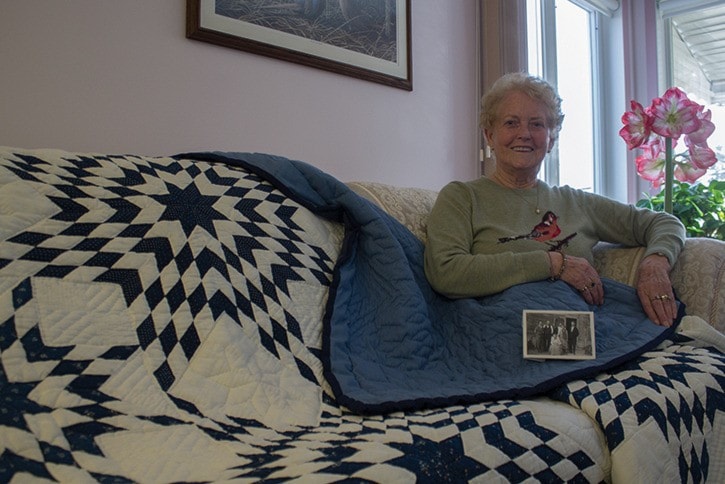The blue-and-white quilt is unassuming from its rack in Sheila Watson's apartment, a well-designed and lovingly sewn piece of bedroom art. The story behind the quilt, though, is what makes the bedspread extraordinary.
The story of the quilt begins with Josie Blair, Watson's great-grandmother. Her great-grandmother was a dominant figure in Watson's early childhood memories, because Blair had raised her father after his mother had died. Growing up near Delburne, some of Watson's happiest memories are on the farm with her great-grandmother and other relatives.
Blair had started the quilt back in those years, cutting out the blue pieces and some of the cream pieces and sewing them together by hand. The quilt, however, was left unfinished when Blair passed away.
The hole left in the family was palpable, as Blair had been a large central figure for everyone.
"Even though I was young, I remember the before and after," Watson recalled. "We'd all go to her place on a Sunday. It was the gathering place for the family. Everyone would be there."
The pieces of the unfinished quilt were passed on to Annie Humphrey, Blair's daughter, but Humphrey never had a chance or the inclination to work on it. The quilt-in-pieces ended up in a chest, which ended up passed on to Humphrey's son, Dale, on her passing.
Like his mother, Dale had no interest in the quilt, but the family connection was too important to just discard the fabric. So, he passed it over to his brother, Claude Blair. From Claude, it came to Watson. Watson and her husband now lived in Stettler, where they raised their family and retired.
"I kept it for I don't know how many years," Watson admitted. "I kept it in a trunk. Then one day, I decided I was going to finish it."
About half of the work on the top of the quilt was done, with the stars pieced together. But only the finished pieces and a few of the pieces cut and ready to be included were there — there was a lot of fabric that wasn't there, which sent Watson on a search to find matching material. That wasn't always easy.
"I did the best I could," Watson said. "Even the light pieces were cream, not white — whether or not that was time or intentional, I don't know."
She also had to make a pattern, since the quilt pattern wasn't included.
"I worked a long time on it," she confessed.
She started working on the quilt about two decades ago, taking it with her for the winter when she and her husband went to Arizona. Working on the quilt while on winter sabbatical became part of her routine and tradition. Once back in Stettler, she was always too busy to work on the quilt, so working on it was a winter tradition.
It took Watson nearly a decade to finish her great-grandmother's quilt, partially because of the fabric quest and the winter-only quilting, but also because Watson decided to finish the quilt how her great-grandmother started it — sewing it by hand.
"At first I went so slow," she said. Watson had quilted before, but had always used a machine. "I wasn't as good a sewer as she was. Her stitches were so small and so perfect. Every stitch was so fine."
As time went on, though, Watson's sewing improved, and with improvement came an increase in speed. "Eventually, I could go faster with it."
As she worked on the quilt, Watson had a lot of time to remember the beloved great-grandmother who had started the quilt, and the family whose hands through which the quilt had passed over the decades.
Now, the quilt hangs covered in plastic on a rack, a piece of protected memory amongst boxes and boxes of photographs and mementos from Watson's life. When she passes on, she doesn't know who the quilt will go to, but she hopes it and the story that comes with it will find a place somewhere in the family.
"When I'm gone, I suppose it won't matter to me," she said with a rueful chuckle. "But I'd like it to be taken care of, given what it means."
